QuickLinks:
700, 701, 702, 703, 704, 705, 706, 707, 708, 709, 710, 711, 712, 713, 714, 715, 716,
717, 718, 719, 720, 721, 722, 723, 724, 725, 726, 727, 728, 729, 730, 731, 732, 733,
734, 735, 736, 737, 738, 739, 740, 741, 742, 743, 744, 745, 746, 747, 748, 749
Page last updated May 10, 2022
Completed entries for IC 708 & 709
WORKING 700: Add historical data
IC 700 (= PGC 35382), "Hickson Compact Group 54"
Discovered (Apr 28, 1892) by Stephane Javelle (198)
A 14th-magnitude spiral galaxy (type SBm? pec) in Leo (RA 11 29 15.3, Dec +20 35 01)
Based on a recessional velocity of 1470 km/sec, IC 700 is about 70 million light years away. Given that, its 1.0 by 0.7 arcmin central region is about 20 thousand light years across, while its 2.6 arcmin wide outer extensions cover about 50 thousand light years. This object was classified as a compact group of galaxies by Hickson, but is actually a single galaxy which is almost certainly a late-stage result of the merger of two former galaxies.

Above, a 2.4 arcmin wide closeup of IC 700
Below, a 12 arcmin wide region centered on the galaxy
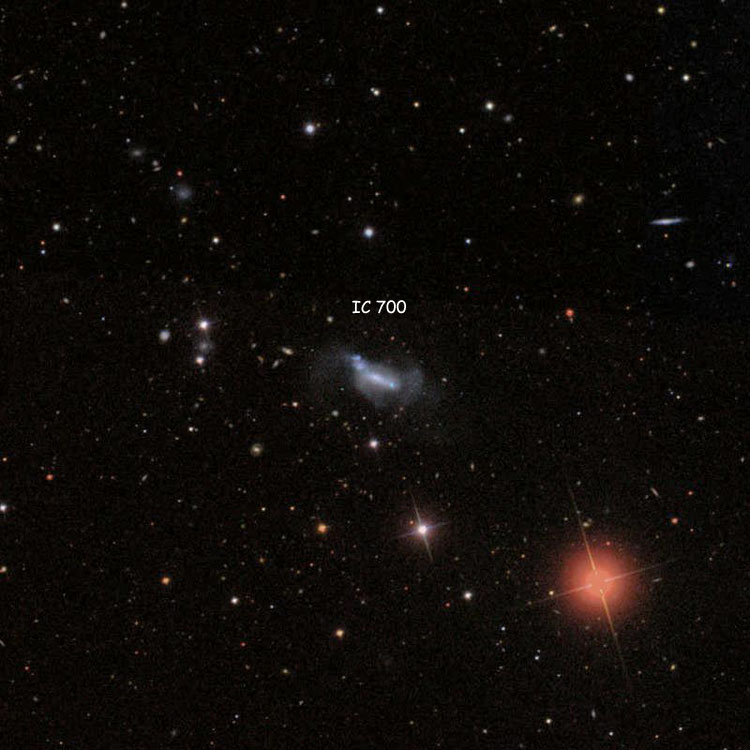
IC 701 (= PGC 35494, and = Arp 197)
Discovered (Apr 22, 1889) by Lewis Swift (VIII-57)
A 15th-magnitude spiral galaxy (type SB(rs)dm pec) in Leo (RA 11 31 00.6, Dec +20 28 09)
Apparent size of main galaxy about 0.7 by 0.55 arcmin; with northeastern extension, about 1.25 by 0.7 arcmin.

Above, a 2.4 arcmin wide closeup of IC 701
Below, a 12 arcmin wide region centered on the galaxy

IC 702 (= PGC 1051683)
Discovered (May 18, 1893) by Stephane Javelle (721)
A 15th-magnitude lenticular galaxy (type S0/a?) in Leo (RA 11 30 54.7, Dec -04 55 20)
Apparent size 0.85 by 0.5 arcmin.

Above, a 2.4 arcmin wide closeup of IC 702
Below, a 12 arcmin wide region centered on the galaxy

IC 703 (almost certainly not = NGC 3704)
Recorded (Apr 21, 1889) by Lewis Swift
A lost or nonexistent object in Crater (RA 11 31 49.2, Dec -11 35 50)
Per Dreyer, IC 703 (Swift list VIII (#58), 1860 RA 11 24 44, NPD 100 49.5) is "most extremely faint, small, round, preceding of 2", the other being IC 704. The position precesses to RA 11 31 49.2, Dec -11 35 50 (whence the position above), but there is nothing there. As noted in its entry, the same is true for IC 704. In fact, per Corwin all the nebulae observed by Swift on the night in question had large, inconsistent errors in their positions, so it is almost certain that the two objects are unidentifiable, and either lost or nonexistent. (It has been suggested that IC 703 and 704 may be poor observations of NGC 3704 and 3707, but their relative positions, separation, and appearance all differ from Swift's observations of the IC objects, so although some references make that connection, it is almost certainly wrong.)

Above, a 12 arcmin wide region centered between Dreyer's positions for IC 703 and 704
IC 704 (almost certainly not = NGC 3707)
Recorded (Apr 21, 1889) by Lewis Swift
A lost or nonexistent object in Crater (RA 11 31 54.2, Dec -11 32 50)
Per Dreyer, IC 704 (Swift list VIII (#59), 1860 RA 11 24 49, NPD 100 46.5) is "extremely faint, very small (perhaps a close double), following of 2", the other being IC 703 (which see for an image). The position precesses to RA 11 31 54.2, Dec -11 32 50 (whence the position above), but there is nothing there. As noted in its entry, the same is true for IC 703. In fact, per Corwin all the nebulae observed by Swift on the night in question had large, inconsistent errors in their positions, so it is almost certain that the two objects are unidentifiable, and either lost or nonexistent. (It has been suggested that IC 703 and 704 may be poor observations of NGC 3704 and 3707, but their relative positions, separation, and appearance all differ from Swift's observations of the IC objects, so although some references make that connection, it is almost certainly wrong.)
IC 705 (= PGC 35644)
Discovered (May 11, 1890) by Lewis Swift (IX-27)
A 15th-magnitude lenticular galaxy (type E/S0?) in Ursa Major (RA 11 32 56.4, Dec +50 14 30)
Apparent size 0.8 by 0.4 arcmin.

Above, a 2.4 arcmin wide closeup of IC 705
Below, a 12 arcmin wide region centered on the galaxy

IC 706 (= PGC 35658)
Discovered (Apr 21, 1892) by Stephane Javelle (199)
A 14th-magnitude lenticular galaxy (type SA0/a?(r)) in Crater (RA 11 33 12.6, Dec -13 20 18)
Apparent size 0.95 by 0.25 arcmin.
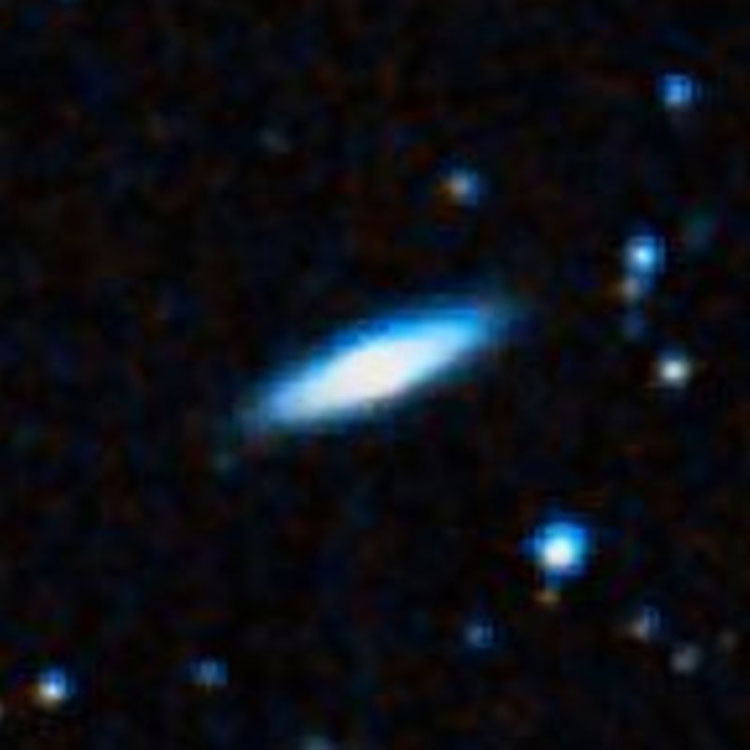
Above, a 2.4 arcmin wide closeup of IC 706
Below, a 12 arcmin wide region centered on the galaxy

IC 707 (= PGC 35708)
Discovered (Mar 29, 1894) by Hermann Kobold (K4)
A 14th-magnitude spiral galaxy (type SAbc?) in Leo (RA 11 33 44.7, Dec +21 22 48)
Apparent size 0.75 by 0.55 arcmin.

Above, a 2.4 arcmin wide closeup of IC 707
Below, a 12 arcmin wide region centered on the galaxy

IC 708, the Papillon Galaxy
(= PGC 35720 = UGC 6549 = CGCG 242-048 = MCG +08-21-056)
Discovered (May 11, 1890) by Lewis Swift
A magnitude 13.0 elliptical galaxy (type E3?) in Ursa Major (RA 11 33 59.3, Dec +49 03 42)
Historical Identification: Per Dreyer, IC 708 (Swift list IX (#28), 1860 RA 11 26 26, NPD 40 09.0) is "extremely faint, small, round, 1st of 4," the others being IC 709, 711 and 712. The position precesses to RA 11 34 04.6, Dec +49 04 38, about 1.3 arcmin northeast of the galaxy above, the description fits and the relative positions of the other "3 of 4" makes the identification certain.
Note About The Nickname: Although this object appears to be an ordinary elliptical galaxy, and in no way looks like a butterfly (or "papillon"), Steve Gottlieb writes that the 1979 paper The "Papillon" radio galaxy IC 708 has a radio emission map that shows a head-tail structure similar to the wings of a butterfly. So although visible-wavelength images show no reason for the nickname there is a reason for it, after all.
Physical Information: Based on a recessional velocity relative to the Cosmic Background Radiation of 6795 km/sec (and H0 = 70 km/sec/Mpc), a straightforward calculation indicates that IC 708 is about 315 to 320 million light-years away, in good agreement with redshift-independent distance measurements of about 215 to 520 million light-years. However, for objects at such distances we should take into account the expansion of the Universe during the time it took their light to reach us. Doing that shows that the galaxy was about 435 million light-years away at the time the light by which we see it was emitted, about 440 to 445 million years ago (the difference between the two numbers being due to the expansion of the intervening space during the light-travel time). Given that and its apparent size of about 1.65 by 1.4 arcmin (including the extended envelope shown in the images below), the galaxy is about 210 thousand light-years across. Its apparent neighbor, IC 709, has an essentially identical recessional velocity and is almost certainly in a physical pair with IC 708.
Note About Radio Image: As noted above in discussing this galaxy's nickname, its radio emission map has a head and tail structure that led to that nickname. The radio emission is believed to be caused by a radio jet, presumably radiating from the accretion disk of a black hole near the center of the galaxy.

Above, a 12 arcmin wide SDSS image centered on IC 708, also showing IC 709
Below a 2.4 arcmin wide SDSS image of IC 708

IC 709
(= PGC 35736 = CGCG 242-049 = MCG +08-21-057)
Discovered (May 11, 1890) by Lewis Swift
A magnitude 13.9 elliptical galaxy (type E1) in Ursa Major (RA 11 34 14.5, Dec +49 02 35)
Historical Identification: Per Dreyer, IC 709 (Swift list IX (#29), 1860 RA 11 26 41, NPD 40 09.5) is "most extremely faint, small, round, 2nd of 4," the others being IC 708, 711 and 712. The position precesses to RA 11 34 19.3, Dec +49 04 07, about 1.7 arcmin north-northeast of the galaxy listed above, the description fits and the relative position of the other "3 of 4" galaxies makes the identification certain.
Physical Information: Based on a recessional velocity relative to the Cosmic Background Radiation of 9700 km/sec (and H0 = 70 km/sec/Mpc), a straightforward calculation indicates that IC 709 is about 315 to 320 million light-years away, in fair agreement with redshift-independent distance measurements of about 405 to 520 million light-years. However, for objects at such distances we should take into account the expansion of the Universe during the time it took their light to reach us. Doing that shows that the galaxy was about 435 million light-years away at the time the light by which we see it was emitted, about 440 to 445 million years ago (the difference between the two numbers being due to the expansion of the intervening space during the light-travel time). Given that and its apparent size of about 0.8 by 0.75 arcmin (from the images below), the galaxy is about 100 thousand light-years across. Its apparent neighbor, IC 708, has an essentially identical recessional velocity and is almost certainly in a physical pair with IC 708.

Above, a 12 arcmin wide SDSS image centered on IC 709, also showing IC 708, 711 and 712
Above, a 1.5 arcmin wide SDSS image of IC 709
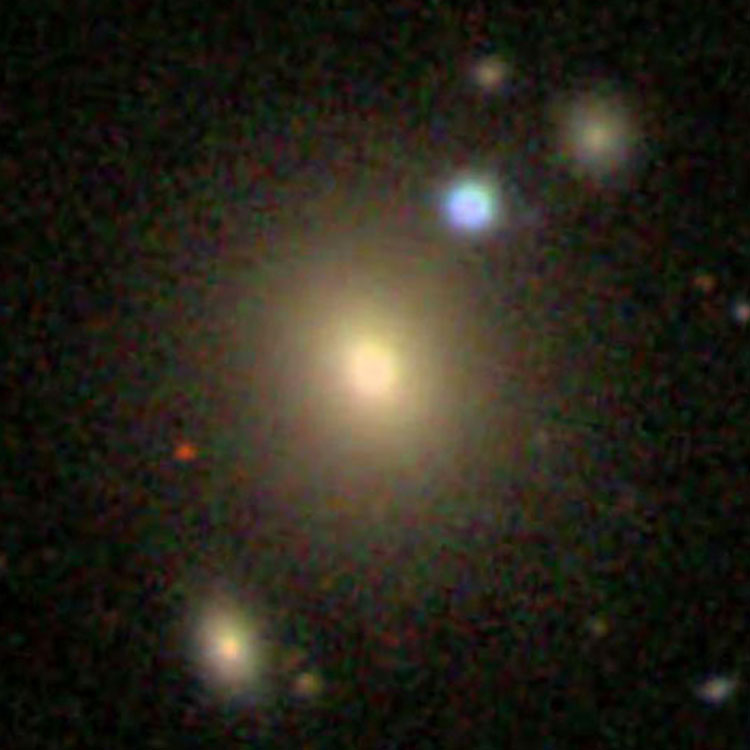
IC 710 (= PGC 35750)
Discovered (Apr 13, 1893) by Stephane Javelle (722)
A 15th-magnitude spiral galaxy (type Sa?) in Leo (RA 11 34 27.3, Dec +25 52 34)
Apparent size 1.0 by 0.65 arcmin.

Above, a 2.4 arcmin wide closeup of IC 710
Below, a 12 arcmin wide region centered on the galaxy

IC 711 (= PGC 35780)
Discovered (May 11, 1890) by Lewis Swift (IX-30)
A 14th-magnitude elliptical galaxy (type E0?) in Ursa Major (RA 11 34 46.5, Dec +48 57 22)
(Though only referred to in the entries for 708 and 709 in the IC, Swift listed this as 3rd of 4 in his paper.)
Apparent size 0.8 by 0.8 arcmin. Although an ordinary elliptical galaxy in visible light, IC 711 is the "head" of a "head-to-tail" radio trail extending all the way to IC 709 (see Vallée & Roger).
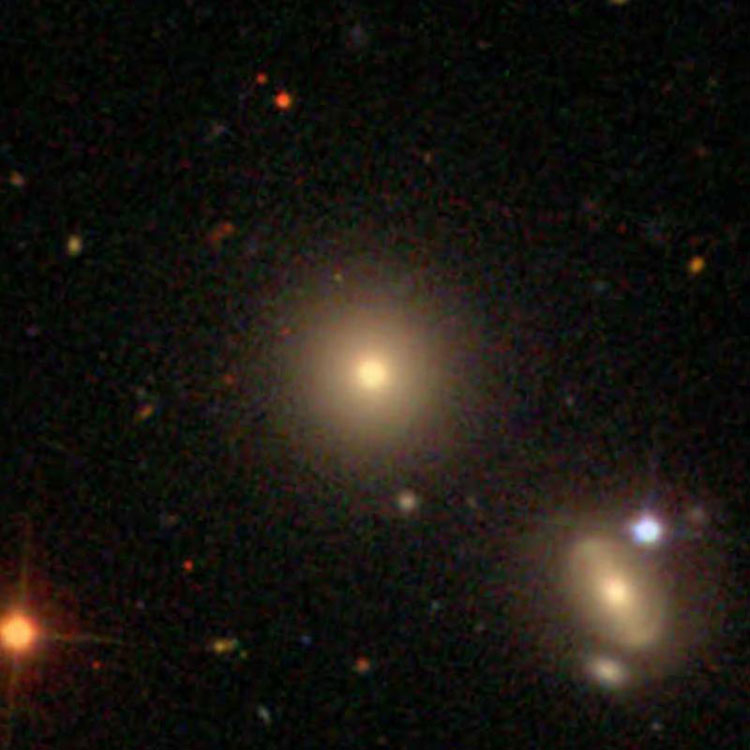
Above, a 2.4 arcmin wide closeup of IC 711
Below, a 12 arcmin wide region centered on the galaxy, also showing IC 709

IC 712 (= PGC 35785)
Discovered (May 11, 1890) by Lewis Swift (IX-31)
A 14th-magnitude elliptical galaxy (type E5?) in Ursa Major (RA 11 34 49.2, Dec +49 04 39)
(Though only referred to in the entries for 708 and 709 in the IC, Swift listed this as 4th of 4 in his paper.)
East of IC 709. Aparent size 2.8 by 1.5 arcmin.
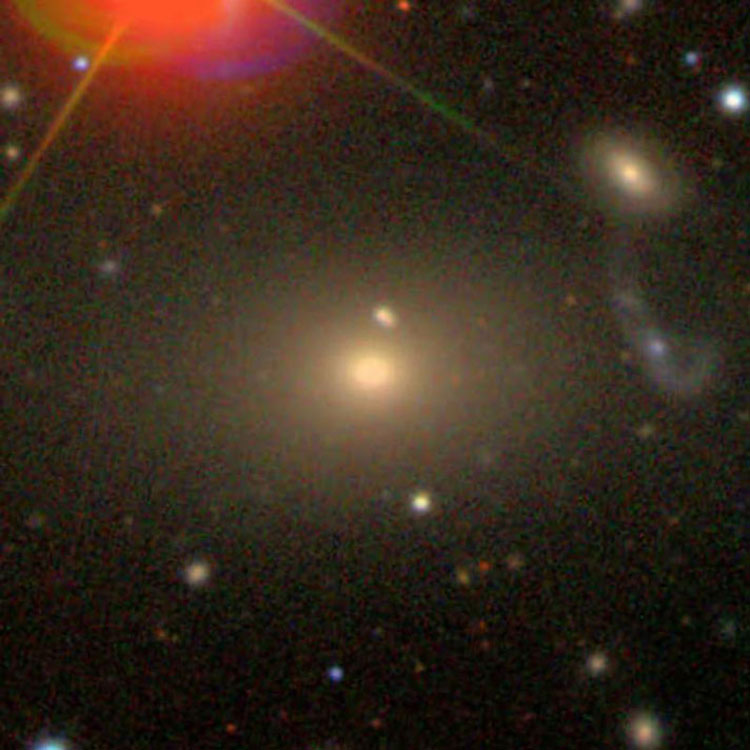
Above, a 3 arcmin wide closeup of IC 712
Below, a 12 arcmin wide region centered on the galaxy, also showing IC 709

IC 713
Recorded (Mar 10, 1886) by Guillaume Bigourdan
An almost certainly nonexistent object in Leo (RA 11 34 45.6, Dec +16 50 36)
Per Dreyer, IC 713 (Bigourdan #164, 1860 RA 11 27 28, NPD 72 23) is "extremely faint, suspected, 3 arcmin north-northeast of 6th-magnitude star". The position precesses to RA 11 34 45.6, Dec +16 50 36 (whence the position above), which is in the correct position relative to 6th-magnitude 90 Leonis, but there is nothing there. Corwin suggests that the object might be an 18th-magnitude star (in the image below, the red dot slightly northwest of Bigourdan's position) at RA 11 34 44.2, Dec +16 50 49, but doubts that Bigourdan could have seen it in the glare from the brighter star. Given Bigourdan's own statement that the object was merely suspected, IC 713 was probably merely an illusory image caused by the glare from 90 Leonis.

Above, a 12 arcmin wide region centered on the position of IC 713
IC 714 (= NGC 3763 = PGC 35907)
Discovered (1880) by Andrew Common (and later listed as NGC 3763)
Discovered (Feb 25, 1887) by Francis Leavenworth (and later listed as IC 714)
A 12th-magnitude spiral galaxy (type SAB(rs)c pec) in Crater (RA 11 36 30.2, Dec -09 50 49)
Per Dreyer, IC 714 ( Ormond Stone (#430), 1860 RA 11 29 24, NPD 99 04.5) is "very faint, pretty small, a little extended 170°, gradually brighter middle and nucleus". (The credit given to Stone is due to the fact that he was the author of the paper, but the entry for #430 shows that Leavenworth was the actual observer.) The position precesses to RA 11 36 30.6, Dec -09 50 57, right on the galaxy, so the identification is certain. Per Corwin, Common's position was also reasonably good, so the duplicate listing was probably due to caution on Dreyer's part not to exclude a possible 'nova' merely because it might be the same as NGC 3763 (which see for anything else).
IC 715 (= PGC 170166 + J2000 113654.8-082244)
Discovered (May 13, 1893) by Stephane Javelle (723)
A pair of galaxies in Crater
PGC 170166 = A 15th-magnitude spiral galaxy (type S?) at RA 11 36 54.2, Dec -08 22 33
J1136548-082244 = A 15th-magnitude spiral galaxy (type S? pec) at RA 11 36 54.8, Dec -08 22 44
Apparent size of PGC 170166 is about 1.5 by 0.6 arcmin. Of its companion, about 1.0 by 1.0 arcmin. Whether the two galaxies are interacting or merely in the same direction is unknown; but the distorted shape of the southeastern galaxy suggests a physical interaction.
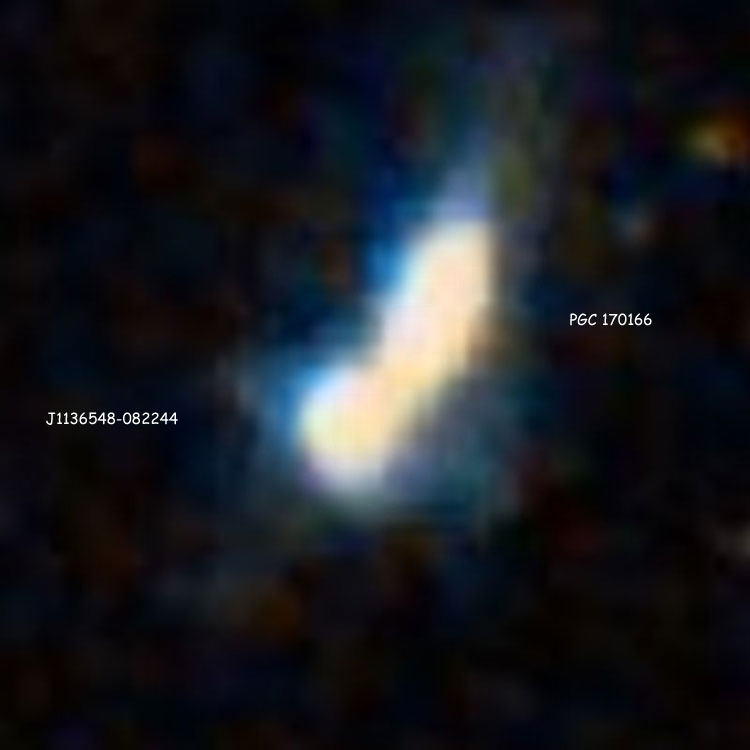
Above, a 2.4 arcmin wide closeup of IC 715
Below, a 12 arcmin wide region centered on the pair

IC 716 (= PGC 36102)
Discovered (Apr 22, 1892) by Stephane Javelle (200)
A 14th-magnitude spiral galaxy (type Sbc pec) in Virgo (RA 11 39 03.4, Dec -00 12 22)
Apparent size 1.7 by 0.3 arcmin.
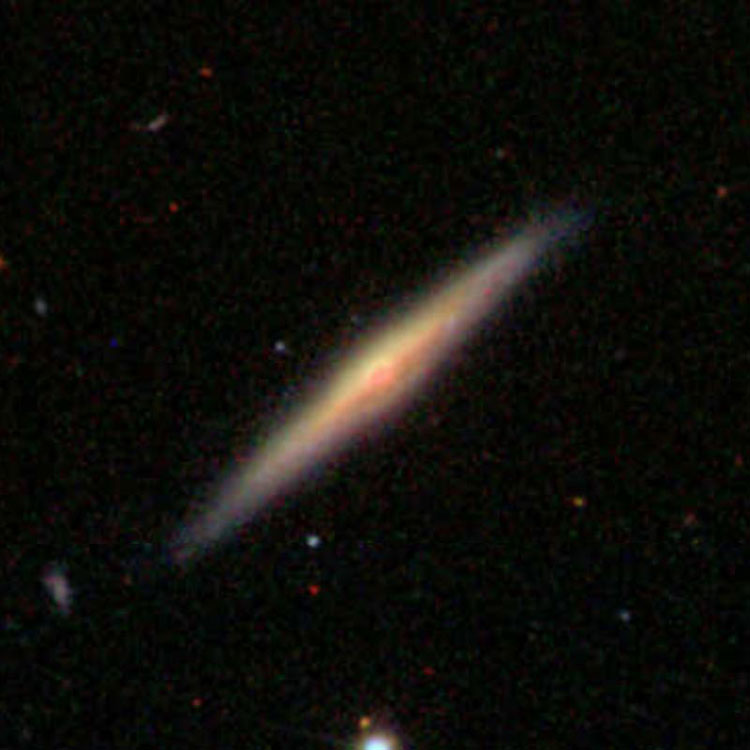
Above, a 2.4 arcmin wide closeup of IC 716
Below, a 12 arcmin wide region centered on the galaxy
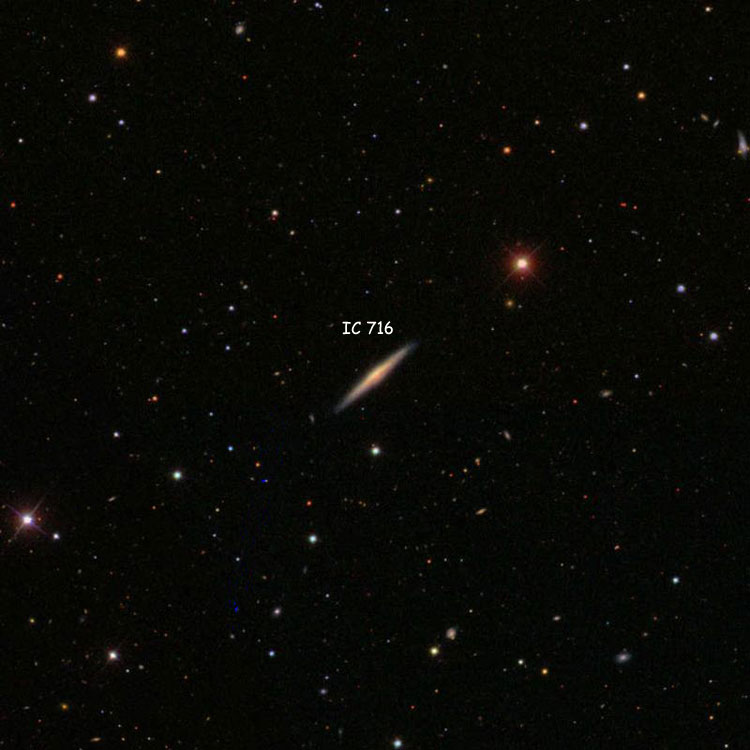
IC 717 (= NGC 3779 = PGC 36084)
Discovered (1880) by Andrew Common (and later listed as NGC 3779)
Discovered (Feb 14, 1888) by Frank Muller (and later listed as IC 717)
A 14th-magnitude spiral galaxy (type SB(s)d pec) in Crater (RA 11 38 50.9, Dec -10 35 01)
Per Dreyer, IC 717 ( Ormond Stone (#433), 1860 RA 11 32 15, NPD 99 52±) is "extremely faint, pretty small, extended east-west, diffuse". (The credit was given to Stone because he was the author of the paper, but the entry for #433 shows that Muller was the actual observer.) The second IC adds "Not found by Howe. Ormond Stone measured Δα= +53.9s from (NGC) 3775, no Δδ (1 observation)" (as in the original IC, the second IC reference to Stone is actually for Muller). Howe's failure to observe the object is presumably due to the fact that Muller's position (and offset from NGC 3775) are wrong (by 30 seconds of time in the latter case). But per Corwin there is no doubt that Muller's object is PGC 36084 (= NGC 3779, which see for anything else), as the description is perfect, and there is nothing else in the area that could possibly be what Muller observed. There appears to be universal agreement with that opinion, so it can be considered essentially certain.
IC 718 (= PGC 36174)
Discovered (Mar 25, 1892) by Rudolf Spitaler (41)
A 14th-magnitude irregular galaxy (type Im?) in Virgo (RA 11 39 52.9, Dec +08 52 27)
Apparent size 1.3 by 0.7 arcmin.

Above, a 2.4 arcmin wide closeup of IC 718
Below, a 12 arcmin wide region centered on the galaxy
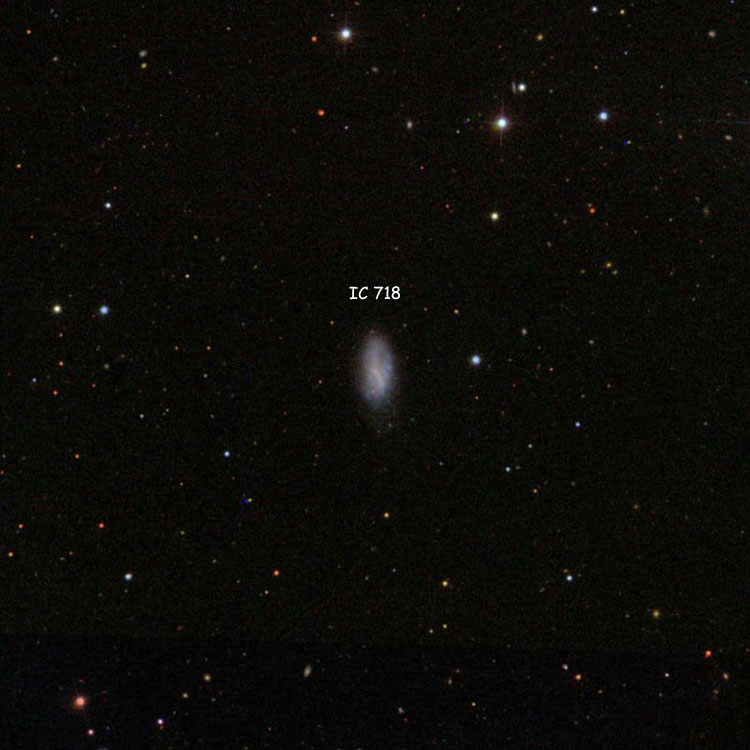
IC 719 (= PGC 36205)
Discovered (Mar 24, 1892) by Rudolf Spitaler (42)
A 13th-magnitude lenticular galaxy (type S0?) in Virgo (RA 11 40 18.6, Dec +09 00 35)
Apparent size 1.7 by 0.55 arcmin.
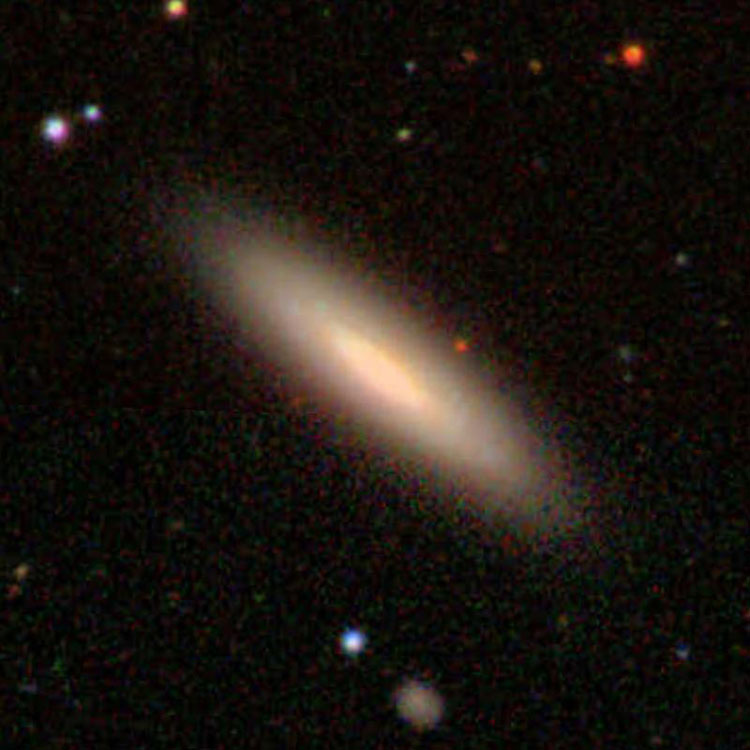
Above, a 2.4 arcmin wide closeup of IC 719
Below, a 12 arcmin wide region centered on the galaxy

IC 720 (= PGC 36333 + PGC 93112)
Discovered (Mar 25, 1892) by Rudolf Spitaler (43)
A pair of interacting galaxies in Virgo
PGC 36333 = A 14th-magnitude lenticular galaxy (type S0/a? pec) at RA 11 42 22.3, Dec +08 46 12)
PGC 93112 = A 15th-magnitude spiral galaxy (type Sab? pec) at RA 11 42 22.3, Dec +08 45 56)
Apparent size of the northern component (PGC 36333) is about 0.7 by 0.6 arcmin, of the southern component (PGC 93112) is about 0.85 by 0.8 arcmin, and of the pair is about 1.2 by 1.0 arcmin.

Above, a 2.4 arcmin closeup of IC 720
Below, a 12 arcmin wide region centered on the pair

IC 721 (= PGC 36354)
Discovered (May 13, 1893) by Stephane Javelle (724)
A 14th-magnitude spiral galaxy (type SB(s)cd?) in Crater (RA 11 42 28.9, Dec -08 20 27)
Apparent size 1.6 by 0.25 arcmin.

Above, a 2.4 arcmin wide closeup of IC 721
Below, a 12 arcmin wide region centered on the galaxy

IC 722 (= PGC 36365)
Discovered (Mar 25, 1892) by Rudolf Spitaler
A 14th-magnitude spiral galaxy (type Sbc?) in Virgo (RA 11 42 43.8, Dec +08 58 27)
Per Dreyer, IC 722 (Spitaler #44, 1860 RA 11 35 24, NPD 80 09.6) is "extremely faint, very small, 10th-magnitude star 2 arcmin to northeast". The position precesses to RA 11 42 37.1, Dec +09 03 49, but there is nothing there. Per Corwin the problem is that Spitaler misidentified his companion star (saying he used BD+09 2531, when he actually used BD+09 2534), and used the coordinates for yet another star (BD+09 2532). This led to positions 8 seconds to the west and 5.5 arcmin north of the actual positions. Correcting for the error puts the position right on the galaxy listed above, and the (12th-magnitude) star to its north-northeast makes the identification certain. (Spitaler made the same mistake for another object he found about a minute of time to the east, IC 724, which see.) Apparent size 1.0 by 0.6 arcmin.

Above, a 2.4 arcmin wide closeup of IC 722
Below, a 12 arcmin wide region centered on the galaxy

IC 723 (= PGC 36384)
Discovered (May 13, 1893) by Stephane Javelle (725)
A 14th-magnitude irregular galaxy (type Irr?) in Crater (RA 11 42 57.6, Dec -08 19 57)
East of IC 721. Apparent size 0.9 by 0.55 arcmin. A Wolf-Rayet galaxy.

Above, a 2.4 arcmin wide closeup of IC 723
Below, a 12 arcmin wide region centered on the galaxy

IC 724 (= PGC 36450)
Discovered (Mar 24, 1892) by Rudolf Spitaler
A 13th-magnitude spiral galaxy (type Sa?) in Virgo (RA 11 43 34.7, Dec +08 56 31)
Per Dreyer, IC 724 (Spitaler #45, 1860 RA 11 36 14, NPD 80 11.2) is "faint, a little extended 45°, small, brighter middle". The position precesses to RA 11 43 27.0, Dec +09 02 13, but there is nothing there. Per Corwin the problem is that Spitaler made the same error with his comparison star as for IC 722 (which see), leading to a right ascension 8 seconds to the west and a declination 5.5 arcmin north of the actual positions. Correcting for the error puts the position right on the galaxy listed above, and the description fits it perfectly, so the identification is certain. Apparent size 2.6 by 1.4 arcmin.

Above, a 2.4 arcmin wide closeup of IC 724
Below, a 12 arcmin wide region centered on the galaxy

IC 725 (= PGC 36444)
Discovered (Apr 7, 1893) by Stephane Javelle (726)
A 14th-magnitude elliptical galaxy (type E0?) in Virgo (RA 11 43 29.4, Dec -01 40 06)
Apparent size 0.75 by 0.75 arcmin.

Above, a 2.4 arcmin wide closeup of IC 725
Below, a 12 arcmin wide region centered on the galaxy

IC 726 (= PGC 213876)
Discovered (Mar 12, 1891) by Rudolf Spitaler
A 16th-magnitude lenticular galaxy (type S0?) in Ursa Major (RA 11 43 45.3, Dec +33 23 30)
Per Dreyer, IC 726 (Spitaler #17, 1860 RA 11 36 25, NPD 55 55.2) is "very faint, pretty large, round". The position precesses to RA 11 43 46.1, Dec +33 18 12, but there is nothing there. Per Corwin the problem is that Spitaler reversed the sign of his offset from his comparison star, placing it 2.06 arcmin south of the star rather than north; and the position listed for the comparison star (BD+34 2257) is an arcmin south of its correct position, so the 1860 NPD should have been 55 50.1, and the corrected J2000 position for IC 726 is RA 11 43 46.1, Dec +33 23 18, almost exactly on the galaxy listed above. As noted by Corwin it seems odd that Spitaler recorded that galaxy and missed the brighter PGC 36455, which lies 2 arcmin to the northwest; but aside from the error in its position, that galaxy would probably have been described as being a little extended, so the identification with the fainter PGC 213876 seems certain. Apparent size 0.6 by 0.4 arcmin.

Above, a 2.4 arcmin wide closeup of IC 726
Below, a 12 arcmin wide region centered on the galaxy, also showing PGC 36455

PGC 36455
Not an IC object but listed here since mentioned in the discussion of IC 726
A 15th-magnitude spiral galaxy (type SBa?) in Ursa Major (RA 11 43 39.7, Dec +33 25 03)
Apparent size 1.1 by 0.4 arcmin.

Above, a 2.4 arcmin wide closeup of PGC 36455; for a wider view see IC 726
IC 727 (= PGC 36536)
Discovered (Apr 23, 1892) by Stephane Javelle
A 14th-magnitude spiral galaxy (type Sab?) in Leo (RA 11 44 28.6, Dec +10 47 02)
Per Dreyer, IC 727 (Javelle #201, 1860 RA 11 37 15, NPD 78 26.3) is "very faint, extremely small, round, (NGC) 3839 to west". The position precesses to RA 11 44 28.4, Dec +10 47 06, right on the galaxy, and the relative position of NGC 3839 is as described, so the identification is certain. Apparent size 1.65 by 0.35 arcmin.
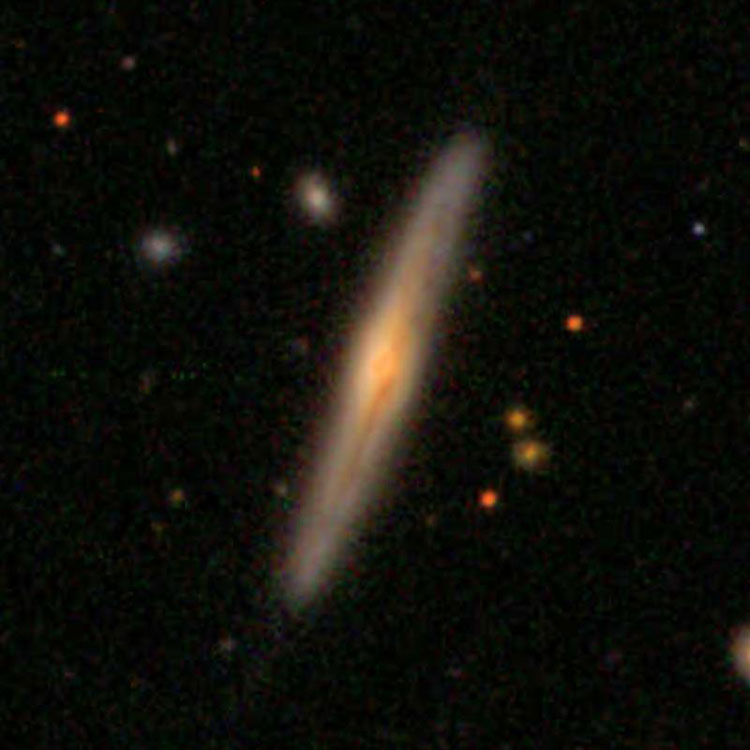
Above, a 2.4 arcmin wide closeup of IC 727
Below, a 12 arcmin wide region centered on the galaxy

IC 728 (= PGC 36580)
Discovered (Apr 7, 1893) by Stephane Javelle (727)
A 14th-magnitude spiral galaxy (type SB(rs)b) in Virgo (RA 11 44 50.5, Dec -01 36 05)
Apparent size 1.3 by 0.6 arcmin.

Above, a 2.4 arcmin wide closeup of IC 728
Below, a 12 arcmin wide region centered on the galaxy

IC 729 (= PGC 36627)
Discovered (Mar 12, 1891) by Rudolf Spitaler (18)
A 15th-magnitude lenticular galaxy (type S0?) in Ursa Major (RA 11 45 18.4, Dec +33 20 09)
Apparent size 0.9 by 0.45 arcmin.

Above, a 2.4 arcmin wide closeup of IC 729
Below, a 12 arcmin wide region centered on the galaxy
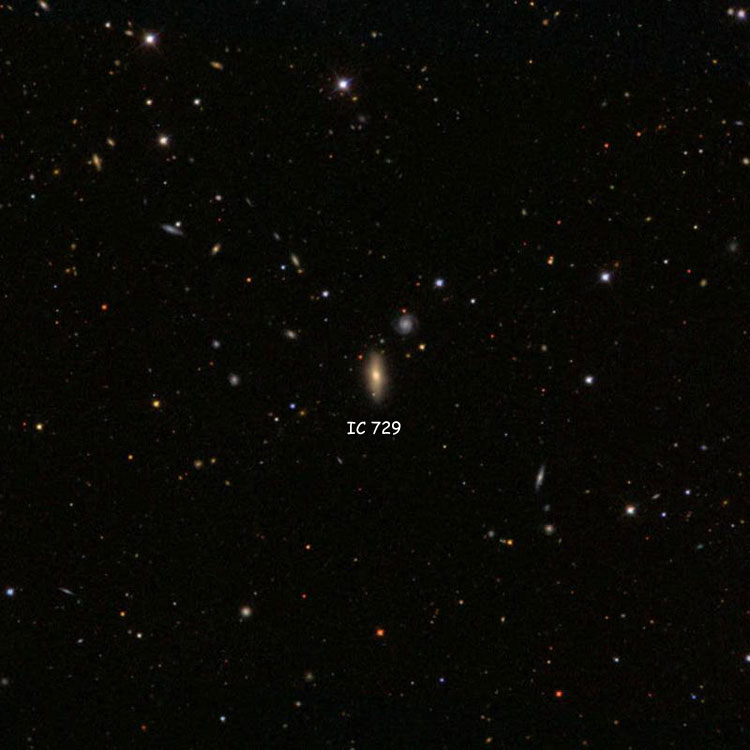
IC 730 (= NGC 3849 = PGC 36658)
Discovered (Feb 11, 1878) by David Todd (and later listed as NGC 3849)
Discovered (Mar 22, 1893) by Stephane Javelle (and later listed as IC 730)
A 14th-magnitude lenticular galaxy (type S0/a? pec) in Virgo (RA 11 45 35.2, Dec +03 13 54)
Per Dreyer, IC 730 (Javelle #728, 1860 RA 11 38 24, NPD 85 59.5) is "faint, very small, round, gradually brighter middle, mottled but not resolved". The position precesses to RA 11 45 35.2, Dec +03 13 52, right on the galaxy, so the identification is certain. Per Corwin the duplicate listing was due to Todd's poor position for the NGC entry. Still, tradition is to give precedence to the earlier catalog listing, so see NGC 3849 for anything else.
IC 731 (= PGC 36626)
Discovered (May 11, 1890) by Lewis Swift (IX-32)
A 15th-magnitude spiral galaxy (type Sc?) in Ursa Major (RA 11 45 18.0, Dec +49 34 13)
Apparent size 0.6 by 0.3 arcmin.

Above, a 2.4 arcmin wide closeup of IC 731
Below, a 12 arcmin wide region centered on the galaxy

IC 732 (= PGC 83488 + PGC 36688)
Discovered (Mar 29, 1886) by Guillaume Bigourdan
A pair of galaxies in Leo
PGC 83488 = A 14th-magnitude spiral galaxy (type Sa?) at RA 11 45 59.8, Dec +20 26 19
PGC 36688 = A 15th-magnitude spiral galaxy (type Sab?) at RA 11 45 59.4, Dec +20 26 50
Per Dreyer, IC 732 (Bigourdan #165, 1860 RA 11 38 44, NPD 68 47) is "very faint, very diffuse". Per Corwin, Bigourdan states in his "big table" (a compilation of all his observations) that the object is "Extremely faint and diffuse, but its existence is certain; I can see brighter points in it which may be stars 13.4 - 13.5 (magnitude)". The position precesses to RA 11 45 59.7, Dec +20 26 22, right on the southern member of the pair listed above, but given Bigourdan's detailed description it appears that he saw more than one object, hence the decision to list IC 732 as the pair of galaxies, rather than merely the southern component; but it is not unusual for one or the other to be listed as IC 732 all by itself (which might be reasonable if only the brighter southern one was listed that way, but the reader is just as likely to see the fainter northern galaxy listed as the IC object, which is certainly wrong). The apparent size of PGC 83488 is about 0.75 by 0.45 arcmin; and of PGC 36688 is about 0.85 by 0.2 arcmin. The two galaxies have similar recessional velocities and are almost certainly at about the same distance from us; but whether they are a physically interacting pair is not obvious, and they could easily be separated by a few million light years, in which case they would certainly not be interacting.

Above, a 2.4 arcmin wide closeup of IC 732
Below, a 12 arcmin wide region centered on the pair, also showing NGC 3884

IC 733 (= PGC 1007508)
Discovered (May 13, 1893) by Stephane Javelle (729)
A 15th-magnitude spiral galaxy (type S?) in Crater (RA 11 45 58.6, Dec -08 09 21)
Apparent size 0.55 by 0.15 arcmin.

Above, a 2.4 arcmin wide closeup of IC 733
Below, a 12 arcmin wide region centered on the galaxy

IC 734 (= PGC 36701)
Discovered (May 13, 1893) by Stephane Javelle
A 15th-magnitude lenticular galaxy (type E/S0?) in Crater (RA 11 46 03.7, Dec -08 16 16)
Per Dreyer, IC 734 (Javelle #730, 1860 RA 11 38 55, NPD 97 29.8) is "faint, small, diffuse". The position precesses to RA 11 46 03.3, Dec -08 16 26, just below the brighter southern member of a pair of galaxies, so the identification seems certain. The question is whether the IC entry should correspond to both objects, or merely the southern one. Although it is generally agreed that IC 734 is only the southern galaxy, some references give the impression that the northern galaxy is also part of the IC entry, so it is discussed immediately below. The apparent size of PGC 36701 is about 0.75 by 0.45 arcmin, while the pair covers an area of about 1.15 by 0.5 arcmin. The recessional velocity of PGC 36701 is 22330 km/sec, which corresponds to a distance of nearly a billion light years, but the recessional velocity of the other galaxy is unknown, so whether they are at the same distance is also unknown.

Above, a 2.4 arcmin wide closeup centered on Javelle's position for IC 734
Below, a 12 arcmin wide region centered on that position

PGC 1005962 (probably not part of IC 734)
Almost certainly not an IC object, but listed here since sometimes treated as if part of IC 734
A 16th-magnitude lenticular galaxy (type E/S0?) in Crater (RA 11 46 03.9, Dec -08 15 54)
Apparent size 0.6 by 0.55 arcmin. See IC 734 for anything else.
IC 735 (= PGC 36849)
Discovered (Apr 23, 1892) by Stephane Javelle
A 14th-magnitude spiral galaxy (type SBm?) in Leo (RA 11 48 12.8, Dec +13 12 31)
Per Dreyer, IC 735 (Javelle #202, 1860 RA 11 40 59, NPD 79 00.6) is "extremely faint, small, irregular figure". The position precesses to RA 11 48 11.6, Dec +10 12 44, but there is nothing there. However, per Corwin Javelle's original paper has a footnote changing the NPD to 76 00.6 (presumably the result of a typographical error being caught during proof-reading, prior to the final printing plates being set). The corrected position precesses to RA 11 48 12.3, Dec +13 12 44, right on the galaxy, so the identification is certain. Apparent size 1.4 by 0.9 arcmin.
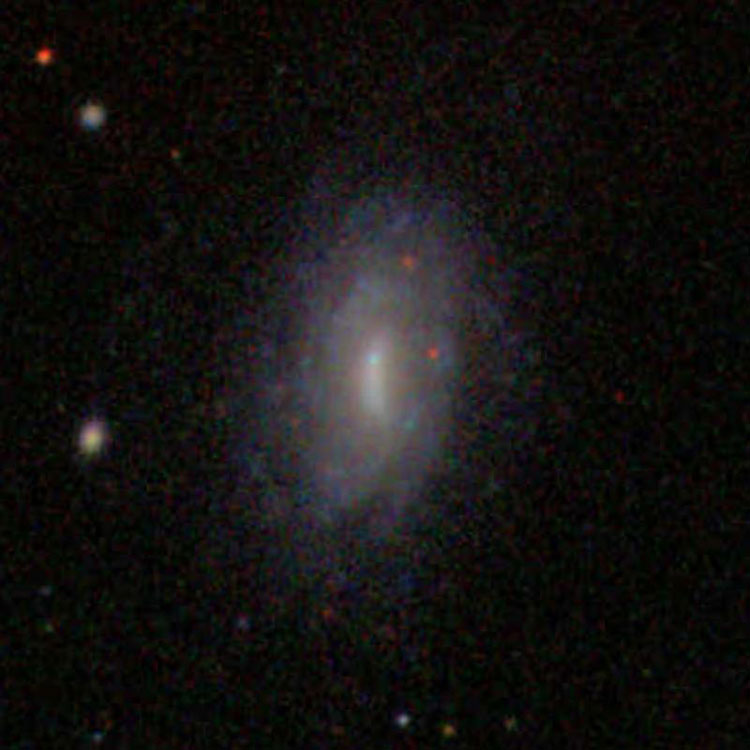
Above, a 2.4 arcmin wide closeup of IC 735
Below, a 12 arcmin wide region centered on the galaxy

IC 736 (= PGC 36853), part of Hickson Compact Group 59
Discovered (Apr 23, 1892) by Stephane Javelle (203)
A 15th-magnitude lenticular galaxy (type E/S0?) in Leo (RA 11 48 20.1, Dec +12 42 59)
Per Dreyer, IC 736 (Javelle #203, 1860 RA 11 41 06, NPD 76 30.4) is "very faint, extremely small, round". The position precesses to RA 11 48 19.2, Dec +12 42 56, right on the galaxy, so the identification is certain. Despite this, the galaxy is often listed as merely PGC 36853, and IC 737 is misidentified as IC 736. The galaxy is one of four galaxies in Hickson Compact Group 59: IC 736, IC 737, PGC 36867 and PGC 36871. Due to the frequent misidentification of IC 737 as IC 736 and PGC 36867 as IC 737, all four members of HCG 59 are discussed on this page. Apparent size 0.7 by 0.6 arcmin.

Above, a 2.4 arcmin wide closeup of IC 736
Below, a 12 arcmin wide region centered on the galaxy, also showing IC 737, PGC 36867 and 36871
(Also see IC 737 for a closeup of HCG 59)

IC 737 (= PGC 36861), part of Hickson Compact Group 59
Discovered (Apr 23, 1892) by Stephane Javelle (204)
A 14th-magnitude lenticular galaxy (type S0/a?) in Leo (RA 11 48 27.5, Dec +12 43 38)
Per Dreyer, IC 737 (Javelle #204, 1860 RA 11 41 14, NPD 76 29.8) is "very faint, extremely small, round, nucleus equivalent to 14th magnitude star". The position precesses to RA 11 48 27.2, Dec +12 43 32, right on the galaxy, so the identification is certain. Despite this, the galaxy is often misidentified as IC 736, and PGC 36867 is misidentified as IC 737. The galaxy is one of four galaxies in Hickson Compact Group 59: IC 736, IC 737, PGC 36867 and PGC 36871. Due to the frequent misidentification of IC 737 as IC 736 and PGC 36867 as IC 737, all four members of HCG 59 are discussed on this page. Apparent size 0.95 by 0.75 arcmin.
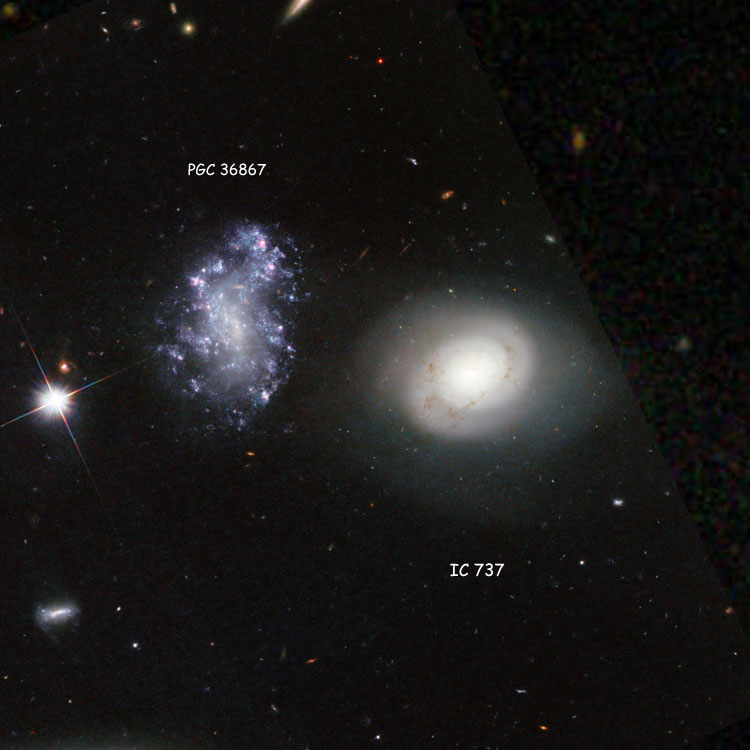
Above, a 2.4 arcmin wide closeup of IC 737 and PGC 36867
Below, a detail of IC 737 (Image Credits above and below: ESA/Hubble/NASA)
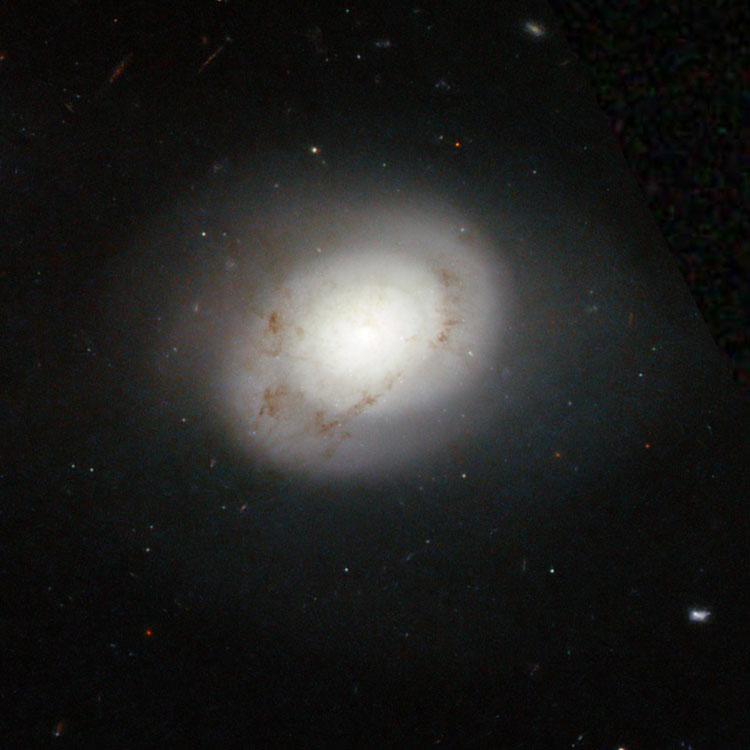
Below, a 4 arcmin wide closeup of Hickson Compact Group 59 (Image Credits as above)

Below, a 12 arcmin wide region centered on the galaxy, also showing IC 736, PGC 36867 and 36871
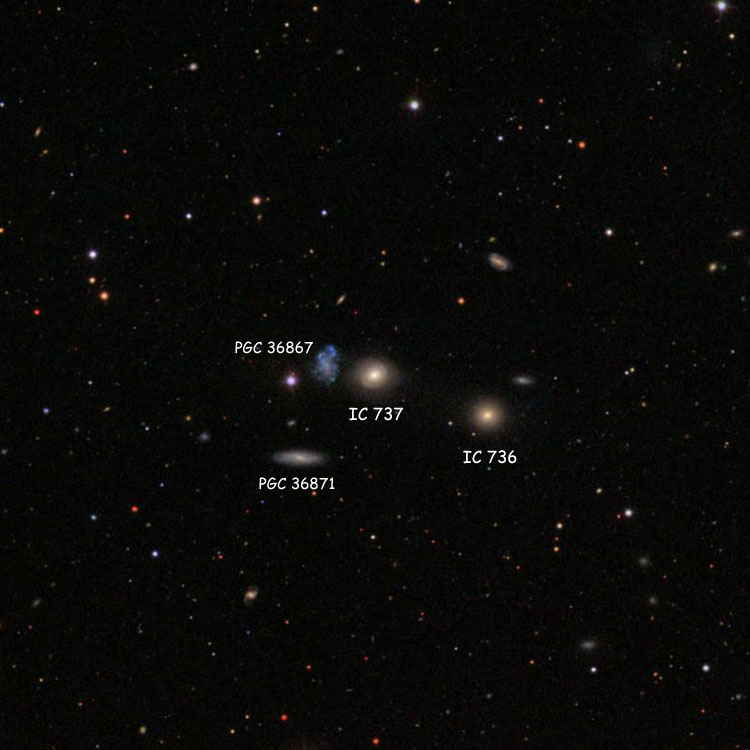
PGC 36867 (not = IC 737), part of Hickson Compact Group 59
Not an IC object but listed here since often misidentified as IC 737
A 16th-magnitude irregular galaxy (type IBm?) in Leo (RA 11 48 30.7, Dec +12 43 48)
See IC 737 for a discussion of the all too frequent misidentification of this galaxy as the IC object. Apparent size 0.65 by 0.45 arcmin.

Above, a detail of PGC 36867 (Image Credits: ESA/Hubble/NASA); for other images see IC 737
PGC 36871, part of Hickson Compact Group 59
Not an IC object but listed here due to common misidentifications within HCG 59
A 15th-magnitude spiral galaxy (type Sc?) in Leo (RA 11 48 32.4, Dec +12 42 19)
Apparent size 0.85 by 0.3 arcmin.

Above, a detail of PGC 36871 (Image Credits: ESA/Hubble/NASA); for other images see IC 737
IC 738 (= PGC 36895, but not PGC 2816780,
and almost certainly not NGC 3915)
Almost certainly not observed (Apr 24, 1784) by William Herschel (and later listed as NGC 3915)
Almost certainly not observed (in or before 1881) by Christian Peters (and later listed as NGC 3915)
Discovered (Jun 3, 1893) by Stephane Javelle (731) (and later listed as IC 738)
A 14th-magnitude spiral galaxy (type Sm? pec) in Virgo (RA 11 48 54.9, Dec -04 40 55)
Historical Identification: Per Dreyer, IC 738 (Javelle #731, 1860 RA 11 41 45, NPD 93 54.0) is "faint, small, round, nucleus = 14th magnitude". The position precesses to RA 11 48 54.4, Dec -04 40 41, barely outside the northern rim of the galaxy listed above, the description fits and there is nothing comparable nearby, so the identification is certain.
Historical Misidentification as NGC 3915: IC 738 is sometimes listed as a duplicate observation of NGC 3915, but as discussed in the entry for that object, NGC 3915 is almost certainly lost or nonexistent, and not only is the position of the two NGC/IC objects very different, but the descriptions are a poor match, and although several galaxies have been suggested as candidates for that entry, Corwin's notes list IC 738 as one of the less likely to be correct, whence the warning in the title for this entry.
Note About PGC Misdesignation: NED lists this as PGC 36895 and as LEDA 2816780. Such duplicate entries in the PGC/LEDA catalog are not uncommon, but in this case the dual identification is a blunder, as PGC 2816780 is a completely different object. One result of this error is that NED lists another recessional velocity of about 16265 km/sec relative to the Cosmic Microwave Background radiation for IC 738, but that value actually applies to PGC 2816780. Such inadvertent application of data for one object to a completely different object is one of the reasons that I make such an effort to point out misidentifications.
Physical Information: Based on a recessional velocity relative to the Cosmic Microwave Background radiation of 2970 km/sec (and H0 = 70 km/sec/Mpc), IC 738 is about 135 to 140 million light years away. Given that and its apparent size of about 0.4 by 0.25 arcmin (from the images below), the galaxy is about 15 to 20 thousand light years across.
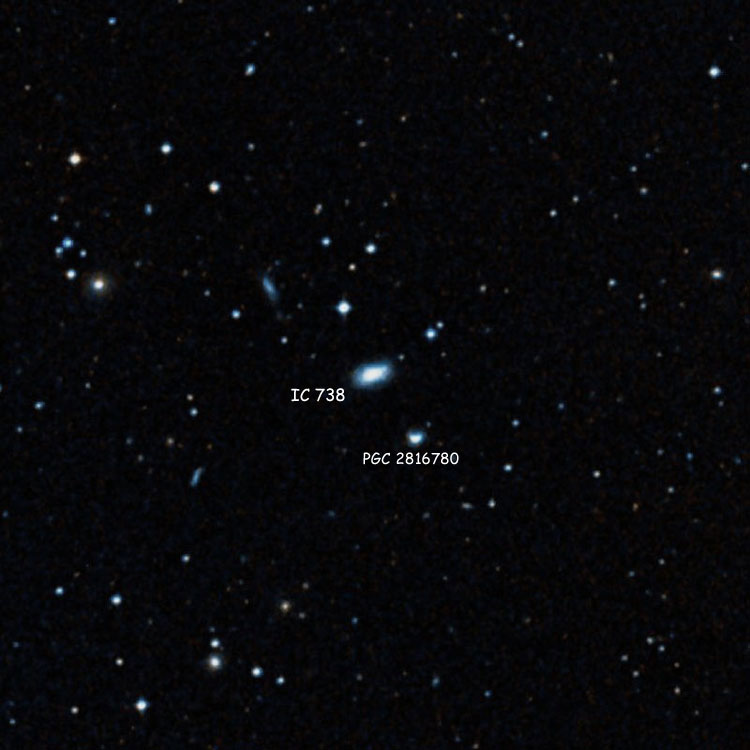
Above, a 12 arcmin wide DSS image centered on IC 738, also showing PGC 2816780
Below, a 1.2 arcmin wide DSS image of the galaxy

Below, a 0.6 arcmin wide PanSTARRS image of the galaxy

PGC 2816780 (not = IC 738)
Not an IC object but listed here since NED misidentifies it as IC 738
A magnitude 16(?) pair of interacting galaxies in Virgo (RA 11 48 52.0, Dec -04 41 55)
Western component (type S0/a? pec) at RA 11 48 51.9, Dec -04 41 55
Eastern component (type E/S0? pec) at 11 48 52.2, Dec -04 41 56
Historical Misidentification: As noted in the entry for IC 738, NED misidentifies LEDA 2816780 as another designation for IC 738, with the result that it lists the recessional velocity of PGC 2816780 as an impossibly large value for the IC object.
Physical Information: Based on a recessional velocity relative to the Cosmic Microwave Background radiation of 16255 km/sec (and H0 = 70 km/sec/Mpc), a straightforward calculation indicates that PGC 2816780 is about 755 to 760 million light years away. However, for objects at such distances we should take into account the expansion of the Universe during the time it took their light to reach us. Doing that shows that the interacting pair of galaxies was about 710 million light years away at the time the light by which we see them was emitted, about 730 million years ago (the difference between the two numbers being due to the expansion of the intervening space during the light-travel time). Given that and its apparent size of about 0.2 by 0.15 arcmin (from the images below), PGC 2816780 is about 40 thousand light years across. Given the complex appearance of the PanSTARRS image, this would undoubtedly be a spectacular object in a high-definition image.
 Above, a 0.5 arcmin wide DSS image of PGC 2816780 (for a wide-field image see IC 738) Above, a 0.5 arcmin wide DSS image of PGC 2816780 (for a wide-field image see IC 738)
Below, a 0.475 arcmin wide PanSTARRS image of the galaxy

IC 739 (= PGC 37097)
Discovered (Apr 19, 1893) by Stephane Javelle
A 14th-magnitude spiral galaxy (type Sab?) in Leo (RA 11 51 31.3, Dec +23 51 45)
Per Dreyer, IC 739 (Javelle #732, 1860 RA 11 43 07, NPD 65 23.9) is "very faint, small, round, 10.5 magnitude star to east". The position precesses to RA 11 50 22.1, Dec +23 49 25, but there is nothing there. Per Corwin, Javelle must have misidentified his comparison star, listing it as BD+24 2401, though it was probably BD+24 2403. This would have produced an error of 71s in the RA and 2.1 arcmin in the NPD. Correcting for that, Javelle's position becomes RA 11 51 33, Dec +23 51 31, which is practically on top of the galaxy listed above, and the 11th-magnitude star to its east makes the identification certain. Apparent size 1.15 by 0.75 arcmin.
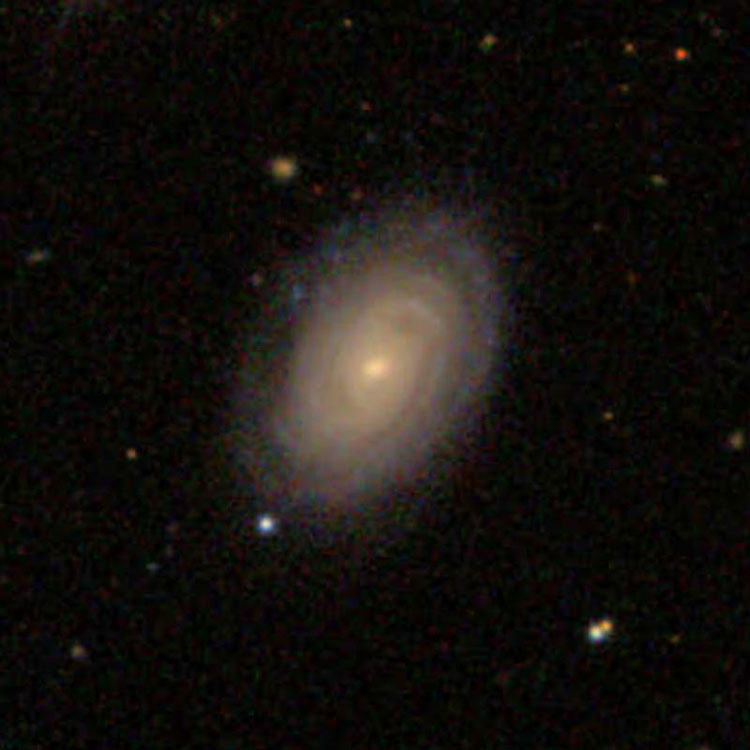
Above, a 2.4 arcmin wide closeup of IC 739
Below, a 12 arcmin wide region centered on the galaxy

IC 740 (= NGC 3913 = PGC 37024)
Discovered (Apr 14, 1789) by William Herschel (and later listed as NGC 3913)
Discovered (May 8, 1890) by Lewis Swift (and later listed as IC 740)
A magnitude 12.6 spiral galaxy (type (R')SA(rs)d?) in Ursa Major (RA 11 50 38.9, Dec +55 21 14)
Per Dreyer, IC 740 (Swift list IX (#33), 1860 RA 11 43 19, NPD 33 52.0) is "most extremely faint, pretty large, irregularly round, II 787 to south", (WH) II 787 being NGC 3916. The position precesses to RA 11 50 44.8, Dec +55 21 18, almost on top of the galaxy, and NGC 3916 is indeed to the south, so the identification is certain.
Discovery Note: Herschel and Swift's right ascensions differed by 18 seconds of time and an arcmin of declination, so neither Swift nor Dreyer realized that this was a duplicate entry. However, at high declinations seconds of time aren't as wide as near the Celestial Equator, so Swift and Herschel's positions actually differ by only about 2.6 arcmin, with Swift's position being slightly east of the center of the galaxy, and Herschel's slightly southwest of the galaxy's outline, and if the two observers had made similar sized errors at a lower declination, either Swift or Dreyer would probably have noticed the duplicate observation.
Physical Information: Given the duplicate entry, see NGC 3913 for anything else.
IC 741 (= PGC 37008)
Discovered (Jun 3, 1893) by Stephane Javelle (733)
A 14th-magnitude lenticular galaxy (type S0/a?) in Virgo (RA 11 50 31.8, Dec -04 50 09)
Apparent size 0.7 by 0.35 arcmin.(from the images below)
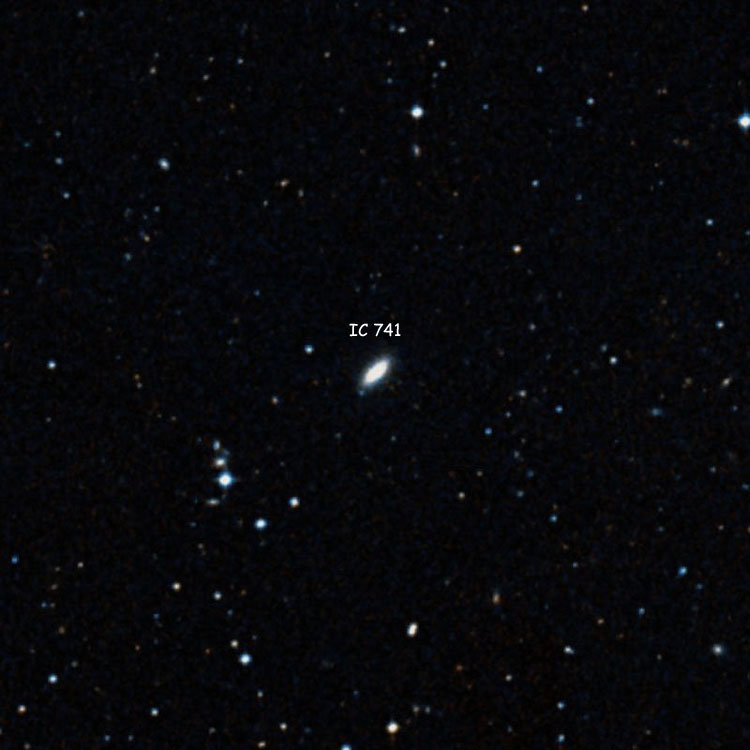
Above, a 12 arcmin wide DSS image centered on IC 741
Below, a 0.9 arcmin wide DSS image of the galaxy

Below, a 0.9 arcmin wide PanSTARRS image of the galaxy

IC 742 (= PGC 37056)
Discovered (Apr 22, 1889) by Lewis Swift (VIII-60)
A 14th-magnitude spiral galaxy (type SB(rs)ab?) in Leo (RA 11 51 02.3, Dec +20 47 58)
Apparent size 1.2 by 1.1 arcmin.
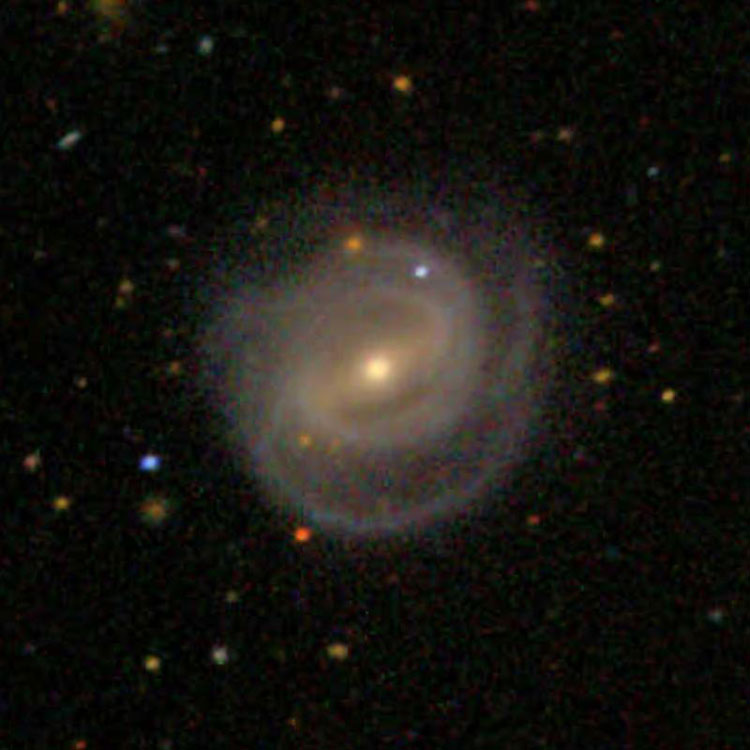
Above, a 2.4 arcmin wide closeup of IC 742
Below, a 12 arcmin wide region centered on the galaxy

IC 743 (= PGC 37267)
Discovered (Apr 19, 1892) by Stephane Javelle (205)
A 15th-magnitude spiral galaxy (type SBc?) in Crater (RA 11 53 22.2, Dec -13 15 51)
Apparent size 1.1 by 0.25 arcmin.

Above, a 2.4 arcmin wide closeup of IC 743
Below, a 12 arcmin wide region centered on the galaxy
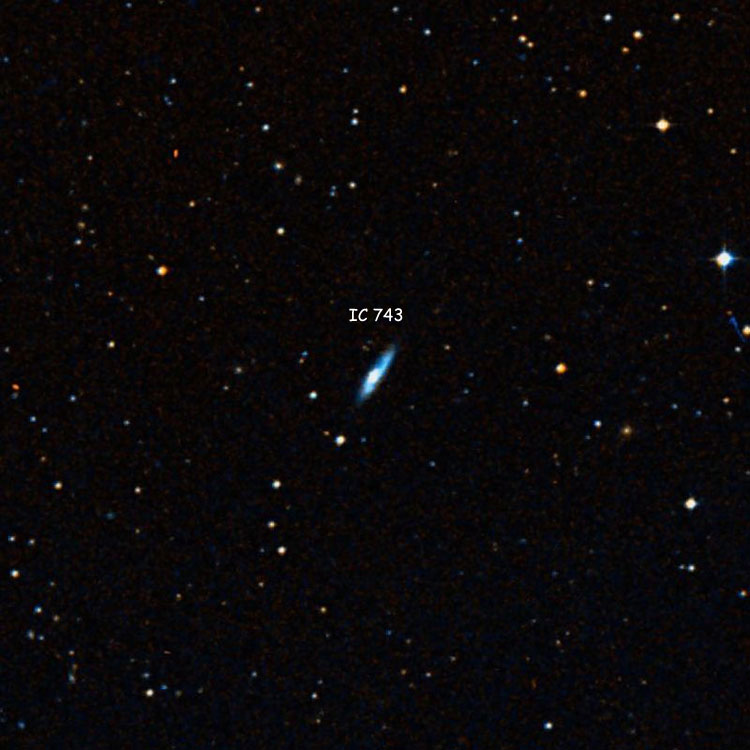
IC 744 (= PGC 37333)
Discovered (Apr 19, 1893) by Stephane Javelle (734)
A 15th-magnitude lenticular galaxy (type SB0/a?) in Leo (RA 11 54 04.8, Dec +23 11 31)
Apparent size 0.6 by 0.3 arcmin.

Above, a 2.4 arcmin wide closeup of IC 744
Below, a 12 arcmin wide region centered on the galaxy
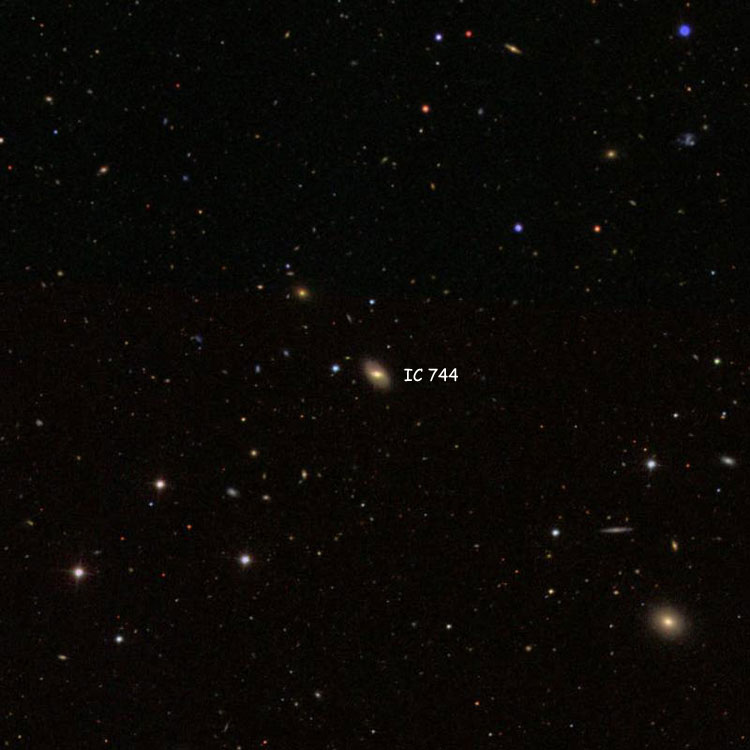
IC 745 (= PGC 37339)
Discovered (Apr 22, 1892) by Stephane Javelle (206)
A 13th-magnitude lenticular galaxy (type S0/a?) in Virgo (RA 11 54 12.3, Dec +00 08 12)
Apparent size 0.8 by 0.75 arcmin. A starburst galaxy.

Above, a 2.4 arcmin wide closeup of IC 745
Below, a 12 arcmin wide region centered on the galaxy

IC 746 (= PGC 37440)
Discovered (Apr 13, 1893) by Stephane Javelle (735)
A 14th-magnitude spiral galaxy (type SBbc?) in Leo (RA 11 55 35.1, Dec +25 53 20)
Apparent size 1.3 by 0.4 arcmin.

Above, a 2.4 arcmin wide closeup of IC 746
Below, a 12 arcmin wide region centered on the galaxy

IC 747 (= PGC 170182)
Discovered (May 13, 1893) by Stephane Javelle (736)
A 14th-magnitude lenticular galaxy (type S0?) in Virgo (RA 11 57 04.9, Dec -08 17 32)
Apparent size 0.65 by 0.4 arcmin.

Above, a 2.4 arcmin wide closeup of IC 747
Below, a 12 arcmin wide region centered on the galaxy
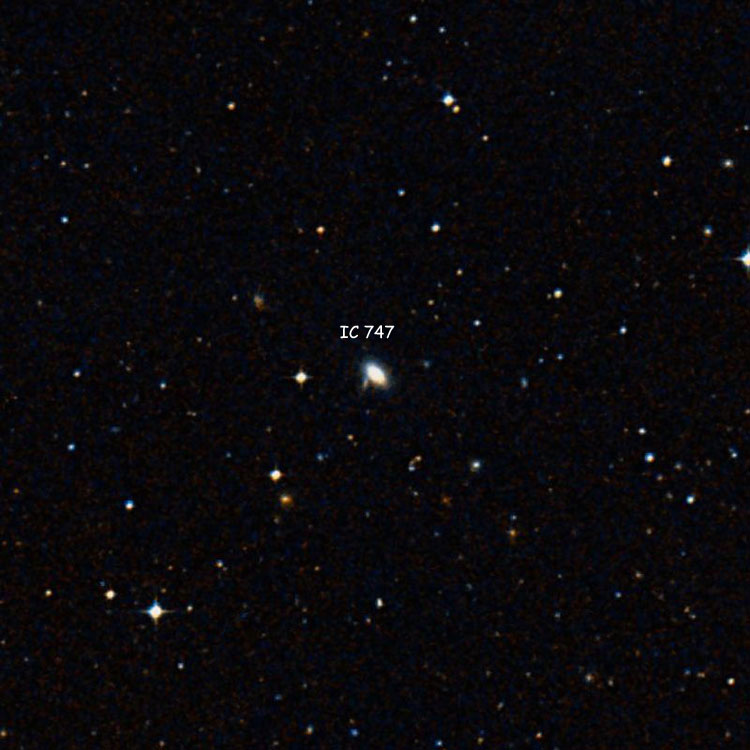
IC 748 (= PGC 37600)
Discovered (Apr 19, 1893) by Stephane Javelle (737)
A 14th-magnitude spiral galaxy (type Sab(r)?) in Virgo (RA 11 57 26.7, Dec +07 27 39)
Apparent size 0.7 by 0.5 arcmin.
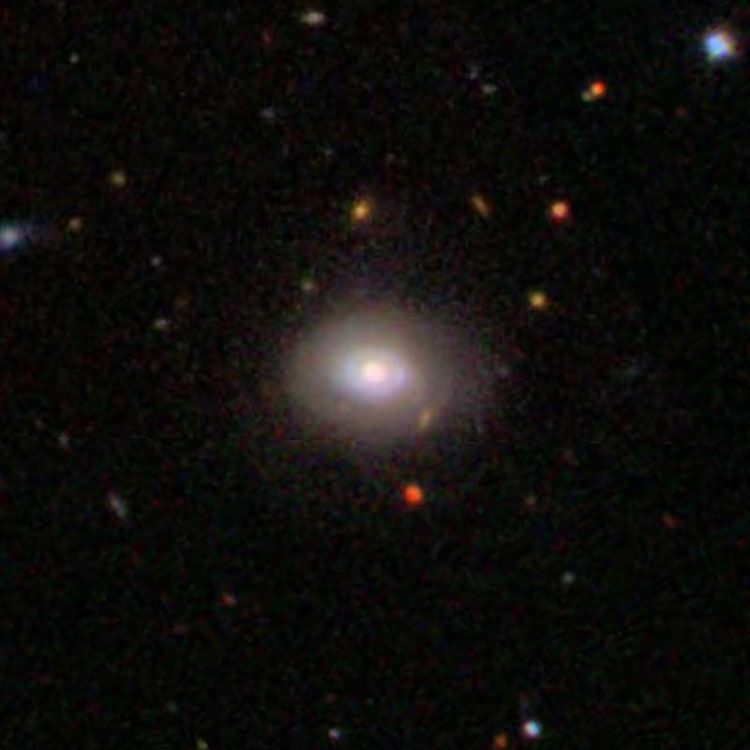
Above, a 2.4 arcmin wide closeup of IC 748
Below, a 12 arcmin wide region centered on the galaxy

IC 749 (= PGC 37692)
Discovered (Apr 22, 1892) by Rudolf Spitaler (46)
A 12th magnitude spiral galaxy (type SAB(rs)cd) in Ursa Major (RA 11 58 33.9, Dec +42 44 03)
Apparent size 2.3 by 2.0 arcmin.

Above, a 2.4 arcmin wide closeup of IC 749
Below, a 12 arcmin wide region centered on the galaxy, also showing IC 750

|